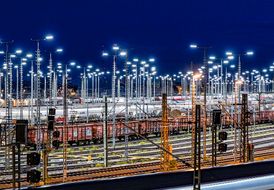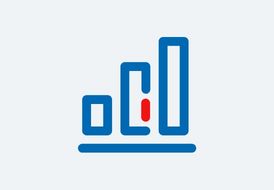Greenhouse gas intensity
The share of renewable energies in the DB traction current mix in Germany is not the only measure by which we manage our progress in climate protection. We also track the development of our specific greenhouse gas emissions in comparison to 2006.
SPECIFIC CO₂e EMISSIONS IN COMPARISON TO 2006 / % | 2021 | 2020 | 2019 | |
DB Group | – 36.1 | – 34.4 | ‒34.8 | |
2021 excluding DB Arriva.
Excluding fleet vehicles, DB Schenker stationary divisions,
DB Arriva and individual divisions of DB Cargo.
As part of our Group climate protection target, we were able to further reduce specific greenhouse gas emissions and are therefore significantly ahead of our forecast from the 2020 Integrated Report. Our absolute greenhouse gas emissions have increased again following a sharp decline resulting from Covid-19, but are still well below the level of 2019.
| SPECIFIC CO₂e EMISSIONS FROM JOURNEYS AND TRANSPORTS OF DB GROUP BY MODE OF TRANSPORT | 2021 | 2020 |
| 2019 | ||
absolute | % | |||||
| Regional rail passenger transport (g/pkm) | 76.5 | 72.6 | + 3.9 | + 5.4 | 48.9 | |
in Germany | 74.1 | 67.9 | + 6.2 | + 9.1 | 47.6 | |
| Long-distance rail passenger transport (g/pkm) | 1.4 | 1.5 | – 0.1 | – 6.7 | 0.9 | |
| Bus transport (g/pkm) | 100.4 | 105.6 | – 5.2 | – 4.9 | 73.8 | |
in Germany | 117.2 | 123.1 | – 5.9 | – 4.8 | 90.9 | |
Rail freight transport (g/tkm) 1) | 17.2 | 17.0 | + 0.2 | + 1.2 | 19.2 | |
Road freight transport | 82.0 | 87.3 | – 5.3 | – 6.1 | 87.9 | |
Air freight (g/tkm) 3) | 657.3 | 669.5 | – 12.2 | – 1.8 | 723.7 | |
Ocean freight (g/tkm) 3) | 5.5 | 5.6 | – 0.1 | – 1.8 | 6.2 | |
Well-to-wheel (WTW); Scope 1–3; rail transport companies are included with their own energy
mix and/or European country mixes.
1) Up to and including 2020 excluding rail freight transport from/to China by DB Cargo and DB Schenker.
2) Up to and including 2020 excluding pre- and onward carriage from land, air and ocean freight.
3) 2021 excluding pre- and onward carriage.
In order to further reduce our greenhouse gas emissions, we are focusing on phasing out fossil fuels. In addition to testing new battery-operated vehicles and converting existing vehicles to hydrogen drives, we are also pushing ahead with the rollout of Biofuels no. 164 Under an overall strategy to phase out diesel, we will be investing about € 40 million in the use of alternative drives and fuels over the next five years as part of a starter package. In terms of alternative fuels, we are focusing on biofuels that are produced from biomassbased residual and waste materials and are therefore not in competition with food and feed production. In addition, it is important to us that the fuel used is free from palm oil and palm fatty acid distillates.
- From May 2022, the Sylt Shuttle will run on climate-friendly biofuel made from hydrogenated vegetable oil (HVO). Conversion work on the associated tank infrastructure is currently underway on the island of Sylt.
- The “Alternative Fuels@DB Cargo” project will continue to promote the use of alternative fuels at DB Cargo. The project includes reviewing the technical and operational feasibility of using HVO and eFuels (synthetic fuels) and the expansion of the EcoSolutions portfolio (DBeco fuel) for DB Cargo customers. The first motor bench tests took place at the beginning of August 2021. In September 2021, field trials of the shunting locomotives under real operating conditions began. The trials were expanded in December 2021 to include the diesel mainline locomotives of the 266 series.
We are also speeding up the heat transition with a new starter package. We intend to ensure our buildings are heated in an environmentally friendly manner and are investing about € 12.5 million over the next five years to achieve this. For example, from 2022 onwards, at the end of their life cycles, oil heating systems will only be replaced by environmentally friendly alternatives. In 2022, we will develop supply concepts for climate-neutral heating of our top 50 locations in Germany.



